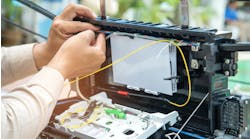Latest from Columnist
Fault Locating the Copper Infrastructure for Bandwidth With the Advent of IoT
The ongoing expectation of extended, reliable and quality bandwidth has always been a maintenance challenge for field technicians and that challenge has increased exponentially with the addition of IoT services. While fiber-to-thehome is the ideal solution for delivering bandwidth, for now, many residential customers depend on copper as the final step in supplying high-end services including IoT.
Field technicians get dispatched on a myriad of problems to restore service, especially on bandwidth circuits that are fiber-to-the-node (FTTN). They are responsible for the cable pair, the drop, inside station wire if applicable, Wi-Fi, modems and other end user equipment. In the old days, a POTS customer could describe problems to the technician. Today with machines talking to machines, troubleshooting can be tougher.
With increasing IoT and other high-end applications, keeping a bandwidth customer happy requires a proactive effort from all involved. Quality testing before dispatch can save truck rolls, but once the technician is dispatched, the ball is in his court. The first step is the most important and the most difficult: Knowing where to start.
The best approach for the technician is to make sure that the narrow band POTS portion riding on the cable pair is functioning properly. The cable pair must be free of DC type faults. Any short, ground cross, crossed battery should be repaired and the cable pair should be tested for series resistance and unacceptable capacitive balance. Then, testing at the network interface for acceptable loop current, network interface ground, circuit loss, circuit noise, power influence, and longitudinal balance is a must before proceeding to the wideband side of the house. Surprisingly, many technicians may not be fully aware of the parameters for quality POTS service. In the process of restoring service, the time sensitive field technician often overlooks these parameters,
so let’s take a look.
Most bandwidth circuits do not require loop current. When needed loop current must provide sufficient current flow to operate supervision and signaling equipment, such as dial tone request or the touch pad on a POTS circuit. Some circuits such as a signaling circuit provide their own current. Insufficient loop current might be the culprit of some customer complaints. When testing for loop current at the minimum point of entry (MPOE), such as a network interface, a transmission test set can simulate any end user equipment from POTS to IoT.
InvisiLight® Solution for Deploying Fiber
April 2, 2022Go to Market Faster. Speed up Network Deployment
April 2, 2022Episode 10: Fiber Optic Closure Specs Explained…
April 1, 2022Food for Thought from Our 2022 ICT Visionaries
April 1, 2022Next, measure the station ground. The station ground must measure less than 25 ohms. If unacceptable, remake or replace it. An unacceptable station ground can affect any or all circuits.
Loss tests measure the sound characteristics of a circuit in decibels (dB). The amplitude of the signal is attenuated by 4 primary factors. They are conductor resistance, conductor inductance, conductor capacitance, and insulation resistance. To test for circuit loss, dial the milliwatt tone and measure loss. Circuit loss should measure less than -8.5 dBm. When a marginal or unacceptable loss is encountered, it is affected by the entire circuit, including bridged tap and wire beyond the customer. If such a condition is suspected, test the neighbor’s pair. If loss is acceptable there, test both pairs for loop treatment. If the acceptable pair is treated, order treatment for the trouble pair. If the neighbor’s pair is not treated, you have a single pair problem such as an unknown lateral or excessive bridged tap (wire beyond the customer’s workout terminal). Only when loop current and circuit loss are found acceptable can circuit noise (noise metallic) and power influence be tested.
Circuit noise (noise metallic) and power influence are interrelated, each being dependent upon the other to form acceptable balance. Circuit noise and power influence are measured to the quiet line termination. Circuit noise should measure less than 20dBrnC and power influence should measure less than 80dBrnC. When Noise metallic is marginal or unacceptable and power influence is acceptable, suspect a pair problem and go after it. The pair is unbalanced either resistively (going open) or capacitively (one side open on a lateral, beyond the work‑out terminal, or crossed with a non‑working pair). In most instances, a capacitive unbalance can be identified and isolated with an open meter. If not, use the location techniques for finding a resistive unbalance. To do this, short and ground the pair at the remote or central office. Measure the resistance tip to ring, tip and ring to ground. This type of problem pertains only to this pair and this customer, tip and ring to ground resistance should be equal and half of the tip to ring ohms, and if they are different the series resistance can be isolated and repaired by the first man out.
When both circuit noise and power influence are marginal or unacceptable, noise mitigation is in order. Suspect a grounding, bonding, or associated power company problem (open capacitor bank, bad transformer, open neutral, etc.). Bonding and grounding are an important part of noise mitigation but I recommend a DSL induction transformer (INT) especially on bandwidth circuits. It will drastically lower the noise floor and increase bandwidth plus protect equipment from lightning.
On the bandwidth side of the house, first look for sync, the fast rate, and the maximum rate, attenuation, margin, and errors. Use the bits per bin graph and the spectrum analyzer to identify interferers and disturbers. Continuous bonding from the central office to the customer will mitigate high frequency interferers, such as AM, ham, and short-wave radio.
Like this Article?
Subscribe to ISE magazine and start receiving your FREE monthly copy today!
Don’t forget to look for dirty power in the house, such as reversed outlets with hot neutral wires, missing grounds, and loose connections — all will have adverse effects on bandwidth. Modems lose sync, set-top boxes drop, and pixelization and freezing occurs on TVs. An AC outlet tester will identify problem AC outlets.
Field technicians are expected to do a quality job on a daily basis. Your feedback helps identify problem areas and install proactive processes to provide quality service to your customer.
Signing off
Looking forward to hearing your thoughts on tough problems you come across in your role as a field technician. We can explore them in the column so others can learn from you. Thank you loyal readers! You, can call or text me at 831.818.3930 or email [email protected].









